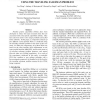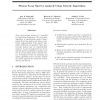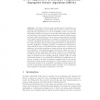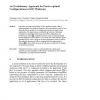IPPS
1998
IEEE
14 years 11 months ago
1998
IEEE
Parallel genetic algorithms (PGAs) have been developed to reduce the large execution times that are associated with serial genetic algorithms (SGAs). They have also been used to s...
GECCO
1999
Springer
14 years 11 months ago
1999
Springer
X-ray spectroscopic analysis is a powerful tool for plasma diagnostics. We use genetic algorithms to automatically analyze experimental X-ray line spectra and discuss a particular...
GECCO
1999
Springer
14 years 11 months ago
1999
Springer
In this paper we present a method based on preference relations for transforming non–crisp (qualitative) relationships between objectives in multi–objective optimisation into ...
ASPDAC
1999
ACM
14 years 11 months ago
1999
ACM
: This paper presents a genetic algorithm based approach for algebraic optimization of behavioral system specifications. We introduce a chromosomal representation of data-flow gr...
IJCNN
2000
IEEE
14 years 12 months ago
2000
IEEE
: This paper describes a rather novel method for the supervised training of regression systems that can be an alternative to feedforward Artificial Neural Networks (ANNs) trained w...
ICMCS
2000
IEEE
14 years 12 months ago
2000
IEEE
We describe a genetic segmentation algorithm for video. This algorithm operates on segments of a string representation. It is similar to both classical genetic algorithms that ope...
IWANN
2001
Springer
14 years 12 months ago
2001
Springer
This paper looks upon the standard genetic algorithm as an artificial self-organizing process. With the purpose to provide concepts that make the algorithm more open for scalabili...
IFIP
2001
Springer
14 years 12 months ago
2001
Springer
: One of the most important problems in SOC platforms design is that of defining strategies for tuning the parameters of a parameterized system so as to obtain the Pareto-optimal s...
EVOW
2001
Springer
15 years 1 hour ago
2001
Springer
Abstract. This work describes the use of genetic algorithms for automating the photogrammetric network design process. When planning a photogrammetric network, the cameras should b...
GECCO
2009
Springer
15 years 3 days ago
2009
Springer
Automatic design of software architecture by use of genetic algorithms has already been shown to be feasible. A natural problem is to augment – if not replace – genetic algori...




